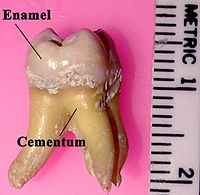
Photo from wikipedia
Mutations of the TRPS1 gene cause trichorhinophalangeal syndrome (TRPS), a skeletal dysplasia with dental abnormalities. TRPS dental phenotypes suggest that TRPS1 regulates multiple aspects of odontogenesis, including the tooth number… Click to show full abstract
Mutations of the TRPS1 gene cause trichorhinophalangeal syndrome (TRPS), a skeletal dysplasia with dental abnormalities. TRPS dental phenotypes suggest that TRPS1 regulates multiple aspects of odontogenesis, including the tooth number and size. Previous studies delineating Trps1 expression throughout embryonic tooth development in mice detected strong Trps1 expression in dental mesenchyme, preodontoblasts, and dental follicles, suggesting that TRPS dental phenotypes result from abnormalities in early developmental processes. In this study, Trps1+/- and Trps1-/- mice were analyzed to determine consequences of Trps1 deficiency on odontogenesis. We focused on the aspects of tooth formation that are disturbed in TRPS and on potential molecular abnormalities underlying TRPS dental phenotypes. Microcomputed tomography analyses of molars were used to determine tooth size, crown shape, and mineralization of dental tissues. These analyses uncovered that disruption of one Trps1 allele is sufficient to impair mineralization of dentin in both male and female mice. Enamel mineral density was decreased only in males, while mineralization of the root dental tissues was decreased only in females. In addition, significantly smaller teeth were detected in Trps1+/- females. Histomorphometric analyses of tooth organs showed reduced anterior-posterior diameter in Trps1-/- mice. BrdU-incorporation assay detected reduced proliferation of mesenchymal and epithelial cells in Trps1-/- tooth organs. Immunohistochemistry for Runx2 and Osx osteogenic transcription factors revealed changes in their spatial distribution in Trps1-/- tooth organs and uncovered cell-type specific requirements of Trps1 for Osx expression. In conclusion, this study has demonstrated that Trps1 is a positive regulator of cell proliferation in both dental mesenchyme and epithelium, suggesting that the microdontia in TRPS is likely due to decreased cell proliferation in developing tooth organs. Furthermore, the reduced mineralization observed in Trps1+/- mice may provide some explanation for the extensive dental caries reported in TRPS patients.
Journal Title: Molecular genetics and metabolism
Year Published: 2019
Link to full text (if available)
Share on Social Media: Sign Up to like & get
recommendations!